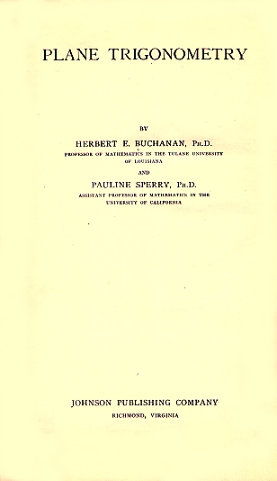Herbert E. Buchanan, Ph.D. and Pauline Sperry, Ph.D.
Plane Trigonometry
Johnson Publishing Company, Richmond, Virginia 1926

Preface
The introduction into American textbooks of general or unified mathematics has opened the way for the exploitation of a wide variety of individual ideas. While there can be no doubt that some of these innovations have had a beneficial effect, others have led to mere eccentricity. It is perhaps due to this fact that so few teachers care to adopt the unified texts as they appear today.
This book is not radical. It is a painstaking effort to utilize all that is good in recent texts, to modernize the older ideas, and to moderate the newer ones.
We wish to call attention to the following outstanding features:
- The Brevity of the Text. The conciseness of the treatment will commend itself to teachers.
- The Full Use of Coordinates. The periodicity properties are discussed both in rectangular and in polar coordinates. So far as we are aware the use of polar coordinates to show the periodicity properties is new. We think it greatly to the student's advantage to become acquainted with both systems early in this training.
- The Use of the Theory of Projection. The remarkably easy and beautiful proof of the addition theorems is thereby made possible.
- No Unnecessary Duplication of Material. This is accomplished by the early introduction of the definitions of the trigonometric functions for the general angle.
- The Introduction of Historical Notes. These are presented wherever they would seem to be of especial interest. This has been done in such a way as not to interrupt the continuity of the text.
- Carefully Selected Exercises. A list of approximately eight hundred exercises is given. These have been gathered from many fields and are calculated to give breadth of training as well as to develop the power of the student to think independently and to cultivate in him an inquiring mind. The text has been planned to meet the needs of students in both engineering and the liberal arts, as is evidenced by the wide variety of applications.
- Accuracy of Numerical Results. Methods of detecting gross errors in the solution of triangles and complete methods of checking are provided, as well as precise statements regarding the degree of accuracy of results.
- The Form of the Tables. While no great change in the form of the tables has been introduced, considerable study has been made with reference to type and spacing in order to make the tables easy and pleasant to use. The accompanying explanations are clear and concise. These tables may be obtained separately or bound with the text according to the needs of the instructor.
- Angles and Their Measures
- Measurements and Computations
- Logarithms and Applications
- Functions of any Angle
- The Addition Theorems
- The General Triangle
- The Inverse Functions and Trigonometric Equations
- Polar Coordinates
